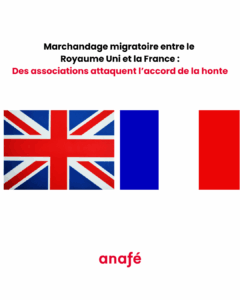Screen, detain, deport – Analysis of the provisions applicable to borders in the New European Pact on Migration and Asylum
On 25 February 2022, Anafé published an analysis of the provisions applicable to borders in the New European Pact on Migration and Asylum, based on its extensive thirty-year experience in assisting foreigners stranded at the French borders and observing practices in zones d’attente. Unsurprisingly the Pact furthers the reinforcement of Europe’s borders, to the detriment of the protection of human rights.
At the end of 2020, the European Commission presented the main guidelines of the next stages to the casting of its migration policy in the form of a New Pact on Migration and Asylum.
By reinforcing screening and border controls, through an asylum procedure taking place at the borders and increasingly repressive practices of detention and refoulement, the Pact appears to sustain the ’Fortress Europe’ and its external borders through a triptych already applied at the French border : screen, detain, deport.
French zones d’attente are physical spaces where foreign persons can be detained when arriving at the Schengen area’s external borders. They can be found in airports, ports and international train stations and are operated by the border police. Foreigners can be detained there, for a maximum of 20 days in principle, when they do not meet the necessary requirements to enter the French territory (that is, accommodation for their whole stay, subscription to a health insurance policy, a return ticket, etc.), if the border police suspect them of being a ‘migration risk’, or if they apply for asylum at the border.
The French authorities often portray the zone d’attente as an effective system to manage its borders, to sort out and repel undesirable persons from its territory. In 2020, 30,794 people were refused entry to the French territory at its border crossing points, and 5,064 were detained in zones d’attente. The number of immediate returns is very significant : 25,730 persons (including potential asylum seekers) were returned immediately. 892 persons filed an admission application to seek asylum on the territory. Moreover, the procedures implemented at the borders are incredibly brief : in 2020, the average detention period was 2.5 days in Paris Charles de Gaulle Airport and even less in other zones d’attente. At last, the rate of deportation was 63% in Paris Charles de Gaulle [1] .
Detaining people at the borders means perpetrating suffering and violence. The violation of human rights is the corollary of this logic. It is, in any case, Anafé’s observation in the light of its experience in the French zones d’attente since 1992. The New Pact, inspired mainly by French border practices, will increase the violations of people’s rights and the physical, moral and institutional violence to which they are already subjected.
Anafé’s analysis takes the opposite approach to the analysis and discourses of the French political leaders by bringing new light to the reality of administrative detention at the external borders of the Schengen area.
Anafé criticises the mechanisms of the proposal for a Regulation on screening and deciphers the logic of administrative detention at the borders. It then focuses on the measures of the Pact regulations concerning particularly vulnerable persons, especially asylum seekers and minors. At last, it evaluates the insufficient safeguards regarding judiciary scrutiny of screening practices, asylum procedures, and administrative detention.
For Anafé, the only solution is a change of perspective, and more broadly a change of policy, on migration and asylum. It is time to put the reception, the legal protection, and the health of foreigners arriving at Europe’s borders at the centre of our concerns.
[1] Sources : Ministry of the Interior and OFPRA.
Sur ces thèmes

Tribunes
Né-es ici ou venu-es d’ailleurs : pour une France de liberté, d’égalité et de solidarité

Communiqués
Pour plus de 200 organisations, le règlement européen « retour » doit être rejeté !

Communiqués
Marchandage migratoire entre le Royaume Uni et la France :Des associations attaquent l’accord de la honte

Communiqués




